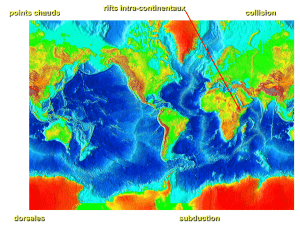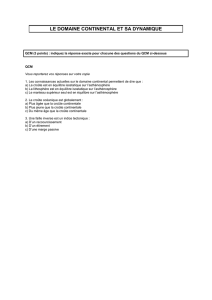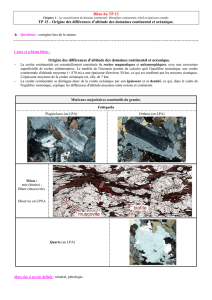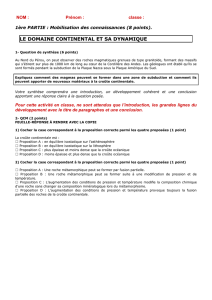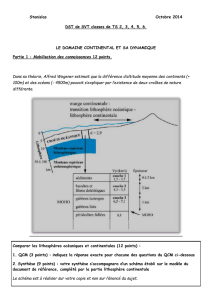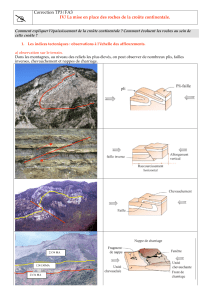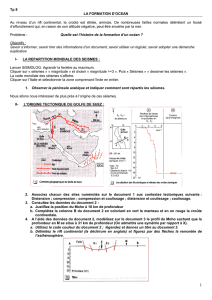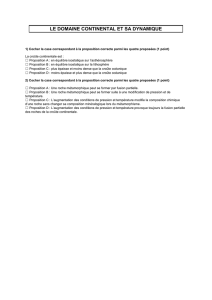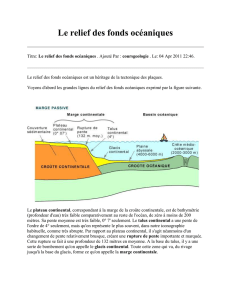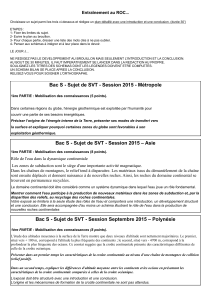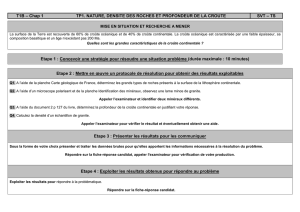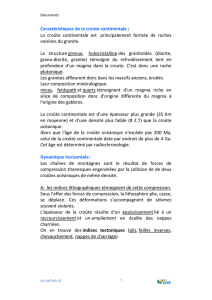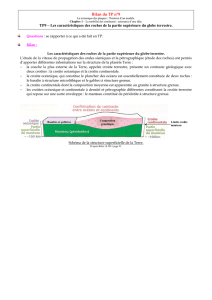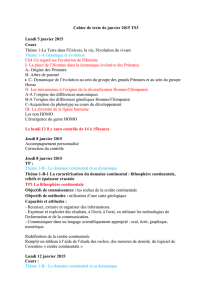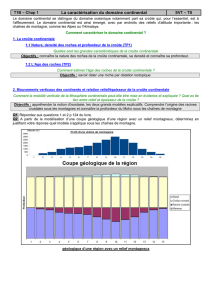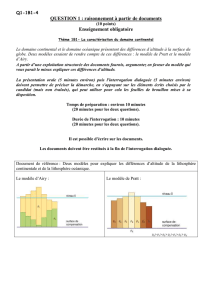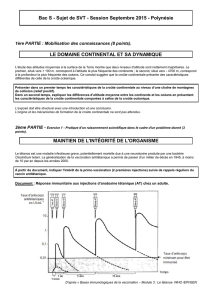les collisions continentales
publicité
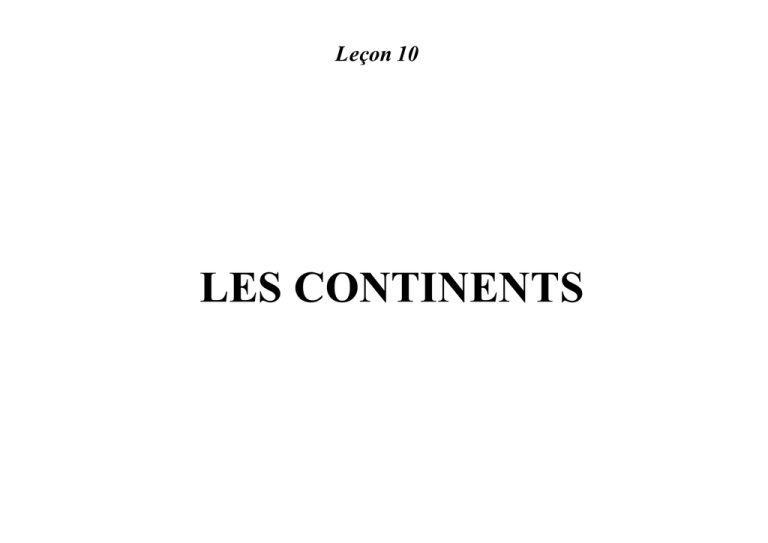
Leçon 10 LES CONTINENTS Leçon 10 QUELLES SONT LES INTERROGATIONS? Les questions: - comment se forme un continent ? - comment grandit-il? - peut-il se détruire? Le plan de la leçon: - 10.1 La structure des continents - 10.2 La croissance par le magmatisme - 10.3 La croissance par collisions - 10.4 La fragmentation - 10.5 le cycle de Wilson - 10.6 Le volcanisme intra-plaque - 10.6 Les marges passives - 10.7 Composition chimique de la croûte continentale 10.1 LA STRUCTURE DES CONTINENTS 10.1.1 LES PROVINCES TECTONIQUES CONTINENTALES 1. Total mass = 0.6% silicate earth 2. Main reservoir for K-U-Th (heat) and mineral resources 3. Primary archive of the Earth history 10.1.2 LA DISCONTINUITE DE MOHOROVOCIC Vp en km/sec profondeur de Moho ~10 km sous les océans ~30 - 40 km sous les continents, jusqu’à 70 km sous les chaînes de montagnes • A sharp seismological boundary • exhibiting Vp jump from 6-7 to >8 km/s • defining the crust/mantle boundary ◆ Generally accepted as gabbro/peridotite boundary 10.1.3 LA CROÛTE CONTINENTALE SUPERIEURE ET INFERIEURE Most accessible; but also most complicated and differentiated. About 30% of the continental area is submerged beneath the oceans. Precambrian shields and platforms (cratons) structure well-known, with Z = 35 - 45 km upper continental crust (UCC) (a) Vp = 5.8 - 6.4 km/sec (UCC), (b) Conrad discontinuity - present or absent (c) Orogenic belts - crustal structures very complicated. Conrad discontinuity lower continental crust (LCC) (a) Vp = 6.5 - 7.2 km/sec (LCC) (b) granulites, magma underplating (c) Moho is transitional, rather than discontinuous. 10.1.4 MIGMATITES ET GRANULITES migmatite granulite 2 cm Les granulites sont le résidu non fondu de l’anatexie. Les magmas granitiques produits, moins denses, remontent vers la croûte supérieure. Les granulites s’accumulent dans la croûte inférieure. 10.1.5 L’ISOSTASIE: L’HYPOTHESE D’AIRY 10.1.6 L’ISOSTASIE: LE PRINCIPE La poussée d’Archimede (buoyancy force) est égale au poids du fluide déplacé par la partie immergée du solide. Surface de compensation about 50 km 10.1.7 GRAVIMETRIE ET RACINE DES CONTINENTS Voir leçon 1 Petit rappel positive negative Poids de la montagne Use a gravity meter to explore local variations in rock density: (mass = density x volume). Poussée d’Archimède 10.1.8 L’ACCUMULATION SOUS-CONTINENTALE (UNDERPLATING) gravimétrie géologie L’addition de matériaux peu denses à la base est compensée par le poids du relief qui se crée. Isostatic readjustment also due to magmatic underplating Rappel leçon 9 M-crustal Melting A- Assimilation S- Storage H-Homogenization 10.1.9 EROSION ET COMPENSATION ISOSTATIQUE Isostatic readjustment in mountain belts. Crustal Rebound – when ice or rocks are removed and the crust continues to rise. Isostatic readjustment also due to de-glaciation. 10.1.10 LE REBOND POST-GLACIAIRE La vitesse du rebond permet de calculer la viscosité de l’asthénosphère dont le toit coïncide avec l’isotherme 1300°C (en moy., à 120 km de profondeur). 10.2 LA CROISSANCE DES CONTINENTS PAR MAGMATISME Popocatépetl, Mexico 10.2.1 RAPPEL: 1 - L’ORIGINE DES MAGMAS MORBs Subduction Continental Le magmatisme continental dérive de la fusion du manteau (anorthosites) ou provient de la fusion de la croûte dans les zones de collision (granites). Il contribue à épaissir la croûte continentale. Nous le distinguerons du magmatisme lié à la fragmentation des continents (rifting). 10.2.1 RAPPEL: 2 – LE ROLE DE L’EAU DANS LA FUSION Adding water changes the melting point Water breaks the Si-O bonds • SiO2 + H2O → 2 Si OH • Acts in the same way that raising temperature does Descending slabs loose water – From hydrated minerals e.g. mica at 100 km – Causes mantle melting – leads to island arc basalts 10.2.3 COMMENT SE FORMENT LES BATHOLITES? • Mantle melts pond at base of crust REACTIONS MAGMAS-CROÛTE • • • Heats lower crust, makes tonalite (assimilation) Tonalite differentiates forming granodiorite and granite Magma ascends through the lithosphere to the level of neutral buoyancy 10.2.4a ASSIMILATION-DIFFERENCIATION SOUS-CRUSTALES 1 – Un exemple: l’origine des anorthosites a. Mantle-derived magma underplates the crust as it becomes density equilibrated. b. Crystallization of mafic phases (which sink), and partial melting of the crust above the ponded magma. The melt becomes enriched in Al. c. Plagioclase forms when the melt is sufficiently enriched. Plagioclase rises to the top of the chamber whereas mafics sink. 10.2.4b ASSIMILATION-DIFFERENCIATION SOUS-CRUSTALES 2 – Un exemple: l’origine des anorthosites d. Plagioclase accumulations become less dense than the crust above and rise as crystal mush plutons. e. Plagioclase plutons coalesce to form massif anorthosite, whereas granitoid crustal melts rise to shallow levels as well. Mafic cumulates remain at depth or detach and sink into the mantle. 10.2.5 LA FUSION DES SEDIMENTS METAMORPHISES L’origine anatectique des granites ANATEXIE: fusion des sédiments métamorphisés lors de la collision. Les roches sont des mignatites. • • • • Slow heating drive off water in pore spaces 680°C: muscovite dehydrates to induce melt – Little muscovite, only 10% melting 760°C: biotite dehydrates – Up to 60% melt Higher: amphibole dehydrates 10.3 LES COLLISIONS CONTINENTALES 10.3.1 LA FERMETURE DES OCEANS TETHYS ET NEOTETHYS La remontée de l’Inde vers la plaque eurasienne provoque la fermeture de la Tethys séparée de la Neotethys par un arc volcanique. Au passage, le point chaud de la Réunion a généré une activité magmatique énorme formant le plateau du DECCAN (voir leçon 9). 10.3.2 LA CHAINE HIMALAYENNE (Poinçonnement) Plasticine model Tapponnier et al., 1982 10.3.3 LES GRANDES STRUCTURES DE LA CHAINE HIMALAYENNE Obduction : phénomène inverse de la subduction qui précède le stade de collision intercontinentale. chevauchement de croûte la océanique - complexes ophiolitiques - sur la croûte continentale. 10.3.4 LES OPHIOLITES DANS L’OBDUCTION OMAN PILLOW-LAVAS Les ophiolites sont des portions de croûte océanique (leçon 9). Leur sommet est formé de basaltes en pillow lavas et leur base de péridotite. En présence d’eau , l’olivine contenue dans ces roches se serpentinise. Olivine: SiO4Mg2 Serpentine: Si2O5Mg3(OH)4 100 µm SERPENTINE chrysotile lizardite 10.3.5 LES COLLISIONS CONTINENTALES DANS LE PASSE: Les chaînes calédonienne et hercynienne Calédonienne: collision de l’Europe du Nord (Avalonia et Baltica) avec l’Amérique du Nord (Laurentia); 550-400 Ma). L’océan Iapetus est fermé au Silurien. Cette chaîne s’est partagée en deux parties par un rift au Dévonien. Qui évolue en un océan (océan Rheique). Les Sables d’Olonne Hercynienne – Alleghanienne: collision de la Laurasie avec le Gondwana vers 300 Ma. Il se forme un supercontinent: la Pangée.. Fermeture de l’océan Rheique. 10.3.5 METAMORPHISME HERCYNIEN AUX SABLES D’OLONNE ~ 300 Ma sillimanite Plis intrafoliaux Métamorphisme de moyenne température – moyenne pression (type Barrowien) Plan de cisaillement grenat 10.3.6 POURQUOI LA FUSION SE DECLENCHE-T-ELLE? Orogenèse récente – actuelle: Himalaya Orogenèse hercynienne (Les Sables d’Olonne) Gneiss non fondu Poches de fusion La déshydratation des sédiments métamorphisés injecte de l’eau dans le système dont la présence abaisse le point de fusion des roches silicatées. 10.4 LA FRAGMENTATION DES CONTINENTS 10.4.1 LA FRAGMENTATION DE LA PANGEE La distribution actuelle des continents vient de la fragmentation du superconinent PANGEE 10.4.2 LA SEPARATION DES CONTINENTS Stade de la PANGEE Début de la fragmentation 160 Ma Trias Jurassique Ouverture de l’Atlantique (vers 80 Ma) Fermeture de la Tethys (vers 40 Ma) Crétacé terminal Eocène 10.4.3 MECANISME DE LA FRAGMENTATION: 1- DOMING AND RIFTING Pure shear rifting Simple shear rifting 10.4.3 MECANISME DE LA FRAGMENTATION: 2 – OUVERTURE D’UN OCEAN Simple shear rifting 10.4.3 MECANISME DE LA FRAGMENTATION: 2 – OUVERTURE D’UN OCEAN 10.4.4 EXEMPLES D’OUVERTURE D’OCEANS Ouverture de l’Atlantique Exemples de branches mortes Jonction des points triples. Une branche sur deux avorte (aulacogène). Les points chauds sont à la jonction des 3 branches. Ils sont marqués par un volcanisme alcalin. Ouverture de la Mer Rouge 10.4.5 LA CAUSE PROFONDE DU RIFTING: UN POINT CHAUD Exemple: le Grand Rift Est Africain Magmatisme alcalin: néphélinite, carbonatite, kimberlite Ces roches se forment par fusion du manteau en présence de CO2 et H2O. Les carbonates remplacent les silicates. Wyllie (1989, Origin of carbonatites: Evidence from phase equilibrium studies. In K. Bell (ed.), Carbonatites: Genesis and Evolution. Unwin Hyman, London. pp. 500-545) and Wyllie et al., (1990, Lithos, 26, 3-19). Winter (2001) An Introduction to Igneous and Metamorphic Petrology. Prentice Hall. 10.4.6 LES DIFFERENTS STADES DU RIFT Exemple: le Grand Rift Est Africain • Pre-rift stage : an asthenospheric mantle diapir rises (forcefully or passively) into the lithosphere. Decompression melting (crosshatch-green indicate areas undergoing partial melting) produces variably alkaline melts. Some partial melting of the metasomatized sub-continental lithospheric mantle (SCLM) may also occur. Reversed decollements (D1) provide room for the diapir. • Rift stage : development of continental melting melting rifting, eruption of alkaline magmas (red) mostly from a deep asthenospheric source. Rise of hot asthenosphere induces some crustal anatexis. Rift valleys accumulate volcanics and volcaniclastic material. • Afar stage : asthenospheric ascent reaches Pure shear rifting crustal levels. This is transitional to the development of oceanic crust. Successively higher reversed decollements (D2 and D3) accommodate space for the rising diapir. Winter (2001) An Introduction to Igneous and Metamorphic Petrology. Prentice Hall. Même échelle horizontale 10.4.7 LE VOLCANISME AU DEBUT DU RITING: LES BASALTES Extends 3700 km. Rifting began in the early Tertiary around the Ethiopian dome. Rifting in the Miocene in Kenya and Tanzania. Qtz Tholeiites, Tholeiites + Alkali Basalts Plateau basaltique (Ethiopie) 10.4.8 APRES LES BASALTES: LE MAGMATISME ALCALIN (HOTSPOT) Motnick Nephelinite/Carbonatite Shombole Nephelinite/Carbonatite Gelia Shield Volcano (alkali basalt) Oldoinyo Lengai (Nephelinite/Carbonatite) Alkaline (Na2O+K2O+CaO>SiO2) , SiO2-undersaturated. Basanites, phonolites, tephrites. CARBONATITES 10.4.9 LES CARBONATITES DU OL DOINYO LENGAI Rare, mantle-derived igneous rock dominated by calcite and dolomite with associated silicates 10.4.10 LES DIAMANTS ECHANTILLONNENT LA CROÛTE PROFONDE ET LE MANTEAU SUPERIEUR néphélinites carbonatites kimberlites Mitchell (1995) Kimb erlites, Orangeites, and Related Rocks. Plenum. New York. Winter (2001) An Introduction to Igneous and Metamorphic Petrology. Prentice Hall. La zone crustale autour du rift est marquée par des volcans très particuliers : les cheminées kimberlitiques qui sont recherchées pour l’exploitation des diamants. 10.4.11 ZOOM SUR LA ZONE CRUSTALE AUTOUR DU RIFT: LES KIMBERLITES 10.4.12 LES INCLUSIONS DANS LES DIAMANTS DES KIMBERLITES (a.) (b.) a.) A purple pyrope garnet, an indicator of garnet harzbugite , Udachnaya pipe, Russia. b.) Orange garnet, typical of diamond eclogite. c.) Red Cr pyrope and green Cr diopside indicators of a peridotite, Mir pipe, Russia. (c.) 10.2 LE CYCLE DE WILSON 10.5.1 LA LOGIQUE DU CYCLE DE WILSON a) The continents are drifting toward a region of cold asthenosphere closing oceans is lined by subduction zones and is contracting. The other ocean is opening, and the oceanic lithosphere is connected to continental lithosphere at both margins. b) The continental fragments have collided, forming a supercontinent. Sbduction has begun along the margins of the formely opening ocean The insulating effects of the thick continental lihosphere lead to the buil upof heat doming and the initiatio of rifting. c) What once was an opening ocean has become a closing ocean, with cool asthenosphere beneath. One Wilson cycle is now complete. Kearey & Vine Global tectonics. Oxford Blackwell Scientific 10.5.2 LES ETAPES DU CYCLE DE WILSON 1. Initiation of rifting 6. Erosion and thinning 5. Continental collision 2. Formation of passive margins, sedimentation 3. Start of convergence 4. Accretion of sediments onto the continent 10.5.3a LA FORMATION DE LA PANGEE 1 - la fermeture de l’océan Iapetus After breakup of Rodinia, Laurentia straddled the equator, its S-side passive margin, Island arc built-up by S-ward subduction of Iapetus 10.5.3b LA FORMATION DE LA PANGEE 2 - les collisions continentales: orogenèse calédonienne Collision of Laurussia with Baltica Océan Rhéique Collision of Gondwana with Laurussia 10.5.3c LA FORMATION DE LA PANGEE 3 – fermeture de l’océan Rheique: l’orogenèse hercynienne Accretion of Siberia Pangea combined 10.6 LES MARGES PASSIVES 10.6.1 LA MORPHOLOGIE DES MARGES PASSIVES ?? Marge stable, asismique, où le passage de la croûte continentale - de nature granitique - à la croûte océanique - de nature basaltique - se fait au sein de la même plaque lithosphérique 10.6.2 LA STRUCTURE DES MARGES PASSIVES Plateau continental: zone plane, légère pente vers le large. Profondeur max: 200 m. Talus continental: pente de 5° de 200 à 4000 m. Glacis continental: pente de 1°, de 4000 à 5000 m, se raccorde aux bassins océaniques. 10.6.3 LA SEDIMENTATION SUR LES MARGES PASSIVES Plateau continental: - les sédiments s’accumulent progressivement vers le large, - leur poids entraîne une subsidence 10.6.4 LE PROBLEME: LA JONCTION ENTRE PLAQUES CONTINENTALE ET OCEANIQUE ? A-t-on le droit de représenter ainsi le contact croûte continentale-croûte océanique? POURQUOI? 10.6.5 LA SOLUTION: LA GEOMETRIE DU RIFTING 1 Le rifting provoque le biseautage de la lithosphère continentale (figure 1) . La croûte océanique commence à se former dans le prolongement du biseau. Lorsqu’elle n’existe pas (figure 2), c’est le manteau supérieur qui affleure directement. Hirth & Guillot, 2013, Elements 2 10.7 COMPOSITION CHIMIQUE DE LA CROÛTE CONTINENTALE 10.7.1 LA COMPOSITION DE LA CROÛTE CONTINENTALE Constraints: 1.Must satisfy the heat flow data. 2.Must have a composition capable of generation of granodiorites by partial melting. 3.Contribution of island arc volcanisms (post-Archean): limited to 25%. 4.Principal period of crustal growth (75%) in the Archean. Results Total crust = 75% Archean crust + 25% "andesite“ SiO2 = 57.3% Cr = 185 ppm, Ni = 105 ppm K = 0.91%, U = 0.91 ppm Th = 3.5 ppm 10.7.2 COMMENT MESURER LA COMPOSITION DE LA CROÛTE CONTINENTALE SUPERIEURE? LE LOESS L’érosion éolienne arrache, déplace et mélange de fines particules que les vents déposent parfois très loin de leur lieu d’origine. Ces dépôts sont d’excellents échantillonnages statistiques de la croûte continentale superficielle. 10.7.3 LA COMPOSITION DE LA CROÛTE CONTINENTALE SUPERIEURE Rudnick & Clarke* Gao, 2003 1889 SiO 2 TiO 2 Al 2O 3 FeO T MnO MgO CaO Na 2O K 2O P 2O 5 60.6 0.7 15.9 6.7 0.10 4.7 6.4 3.1 1.8 0.13 60.2 0.6 15.3 7.3 0.10 4.6 5.5 3.3 3.0 0.23 Mg# 55.3 53.0 F.W. Clarke, 1847-1931 *chaque valeur moyenne de la composition s’appelle le CLARKE Prochaine leçon: EXERCICES
